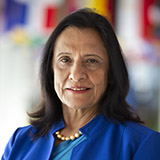In the WHO South-East Asia Region, the fight against TB has reached a critical phase. Financing within countries must be streamlined, and global investment forthcoming
At last year’s UN General Assembly (UNGA) high-level meeting on ending TB, Indian TB survivor Nandita Venkatesan’s message was urgent, bold and decisive: “You must act now.” At the close of Ms Venkatesan’s speech, Heads of State and government from across the world stood and applauded for two whole minutes. It was a fitting testament to the TB survivor, advocate and journalist’s courage and resolve.
But the ovation reflected an additional and important truth: the power of words and their ability to mobilize action and accountability. Given the Political Declaration on the Fight against TB that was subsequently endorsed, and which sets a series of interim targets crucial to ending TB by or before 2030, that truth is especially significant. There is not a moment to lose in recognizing and acting on it.
In fulfilling the Declaration’s targets, the WHO South-East Asia Region will do much of the heavy lifting. Not only does the Region account for almost half of the 10 million people who contract TB every year; it also makes up more than 50% of the 1.27 million TB deaths which, when TB-HIV mortality is accounted for, is estimated to be 1.6 million annually. [1] That means of the 40 million people that require diagnosis and treatment as per the global Declaration, at least 18 million will come from the South-East Asia Region. And of the 30 million that require preventive treatment, the Region will cover at least 12 million. [2]
Though this is an ambitious task, it is well within the Region’s scope. Why? Because for the better part of the last three years, political leaders Region-wide have demonstrated in word and deed their commitment to ending TB once and for all.
In March 2017, for example, each of the Region’s Member States issued a Call for Action, highlighting the political, technical and strategic interventions needed to achieve their objective. That was followed by significant increases in budgetary allocations to address TB, alongside the intensification of a range of policies. A Statement of Action was then universally adopted in 2018, pledging to intensify action, while several of the Region’s Member States organized key side-events at the UNGA to enlist support for the Declaration. Member States’ TB budgets have, in aggregate, more than doubled (India’s domestic budget has trebled).
As bold as the Region’s initiatives are, however, to achieve the Declaration’s targets, momentum must be sustained, and progress accelerated. Among other key interventions, that means intensifying active case-finding, developing strategies to treat at-risk communities, harnessing innovative technologies (including via south-south cooperation and royalty-free technology transfers), and better leveraging community engagement.
Crucially, it also means finding ways to overcome financial bottlenecks to ensure funds are not only spent wisely, but that they are spent at all. In 2017, for example, USD 117 million of allocated funds lay dormant. [3] As the Region’s 2018 Statement of Action emphasizes, to ensure TB programmes are efficiently financed, Member States must strengthen governance structures, create purpose-built fund-flow mechanisms, enhance flexibility so that spending reflects local needs, and actively promote political commitment and buy-in at the sub-national level.
WHO is working with Member States to ensure they can fully leverage the funds needed to achieve the Declaration’s targets. Nevertheless, as the Declaration itself outlines, regardless of the strength of Member States’ political commitment and the structures and systems in place to achieve their objectives, present resources will scarcely be enough to drive the progress needed.
Against a Regional resource need of USD 2 billion annually, for example, in 2018 the funding allocated failed to reach USD 1 billion. Out of this, USD 0.6 billion was required from domestic sources, while close to USD 0.2 billion was expected from Global Fund (with the amount delivered dependent on in-country capacity). USAID was the next largest donor, with an allocation of USD 30 million. While the additional need for countries varies – from around USD 0.5 billion in India and USD 0.3 billion in Indonesia to USD 1 million and below for smaller countries like Bhutan, Maldives and Timor-Leste – the needs are very much present. To this day, the Region’s funding gap is USD 1.1 billion – a substantial and potentially decisive shortfall. [4]
That needn’t be the case. The UN General Assembly’s Political Declaration is a landmark document. It is the product of years of advocacy, from New Delhi to Moscow and from Geneva to New York. Whatever its shortcomings, we are right to celebrate the Declaration as opening a new phase in the fight against TB. But its significance will only be realized if greater action and accountability are achieved, the power of its words are recognized, and the path-breaking change so desperately required is catalyzed. Sleepwalking towards 2030 is not an option. Action is needed, and now.
Poonam Khetrapal Singh is the Regional Director for WHO South-East Asia
Competing interests: None declared
References:
- World Health Organization. Global Tuberculosis Report 2018. 23rd Edition. WHO, Geneva. 2018.
- United Nations General Assembly. 18 October 2018. http://www.un.org/en/ga/search/view_doc.asp?symbol=A/RES/73/3 accessed 18 March 2019
- World Health Organization. Global Tuberculosis Report 2018. 23rd Edition. WHO, Geneva. 2018
- Bending the Curve – Keeping our Promise of Ending TB in the South-East Asia Region on time. WHO, SEARO 2018.

